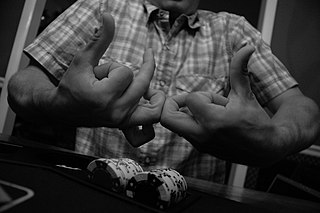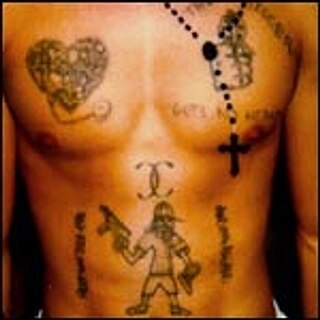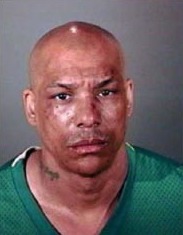
The Bloods are a primarily African-American street gangs which was founded in Los Angeles, California. The gang is widely known for its rivalry with the Crips. It is identified by the red color worn by its members and by particular gang symbols, including distinctive hand signs.

Raymond Lee Washington was an American gangster, known as the founder of the Crips gang in Los Angeles. Washington formed the Crips as a minor street gang in the late 1960s in South Los Angeles, becoming a prominent local crime boss. In 1971, Washington formed an alliance with Stanley "Tookie" Williams, establishing the Crips as the first major African-American street gang in Los Angeles, and served as one of the co-leaders. In 1974, Washington was convicted of robbery and received a five-year prison sentence, during which his leadership and influence in the Crips declined.

The Community Resources Against Street Hoodlums (CRASH) was a specialized gang intelligence unit of the Los Angeles Police Department (LAPD) tasked with combating gang-related crime between 1979 and 2000. The unit was established in the South Central district of Los Angeles, California, United States, to combat rising gang violence during the period. Each of the LAPD's 18 divisions had a CRASH unit assigned to it, whose primary goal was to suppress gang-related crimes in the city, which came about primarily from the increase in illegal drug trade.

The Rampart Division of the Los Angeles Police Department (LAPD) serves communities to the west of Downtown Los Angeles (DTLA) including Silver Lake, Echo Park, Pico-Union and Westlake, all together designated as the Rampart patrol area. Its name is derived from Rampart Boulevard, one of the principal thoroughfares in its patrol area. The original station opened in 1966, located at 2710 West Temple Street. In 2008, the staff moved southeast to a newer facility located at 1401 West 6th Street. With 164,961 residents occupying a 5.4-square-mile (14 km2) area, Rampart is one of Los Angeles's most densely populated communities.

The Rollin 60s Neighborhood Crips is a street gang based in Los Angeles, California, originally formed in Los Angeles in 1976 from the Westside Crips and having since spread to other cities in the United States. Membership is estimated to be around 1,600 people, making it one of the largest gangs in the Los Angeles area.

The Crips are an alliance of street gangs that is based in the coastal regions of Southern California. Founded in Los Angeles, California, in 1969, mainly by Raymond Washington and Stanley Williams, the Crips began as an alliance between two autonomous gangs, and developed into a loosely connected network of individual "sets", often engaged in open warfare with one another. Its members have traditionally worn blue clothing since around 1973.
The Watts truce was a 1992 peace agreement among rival street gangs in Los Angeles, California, declared in the neighborhood of Watts. The truce was reached just days before the 1992 Los Angeles riots and, although not universally adhered to, was a major factor in the decline of street violence in the city between the 1990s and 2010s.
The Jungles faction of the Black P. Stones street gang is a division ("set") of the Bloods gang alliance in Los Angeles. Originating in Los Angeles' Baldwin Village neighborhood in the 1960s, the Black P. Stones became one of the largest gangs in the city. The gang has been linked to various crimes, including murders, assaults, robberies, narcotics violations and firearms violations, and has been the subject of numerous FBI and LAPD investigations.

Dead Homiez was filmed on location in South Central Los Angeles. The film stars the Notorious B.I.G. and 2Pac. The movie also stars Treyvon Green and Cynthia Berry. The director of the movie was Billy Wright.

The Pirus are a subset of the larger Bloods gang alliance, an organized crime group in the United States.

Sanyika Shakur, also known by his former street moniker Monster or Monster Kody, was an American author and former gangster. He was a member of the Los Angeles-based Eight Tray Gangster Crips. He got his nickname as a 13-year-old gang member when he beat and stomped a robbery victim until he was disfigured. Shakur claimed to have reformed in prison, joined the Republic of New Afrika movement, and wrote a 1993 memoir called Monster: The Autobiography of an L.A. Gang Member.

Crips and Bloods: Made in America is a 2008 documentary by Stacy Peralta that examines the rise of the Crips and Bloods, prominent gangs in America who have been at war with each other. The documentary focuses on the external factors that caused African-American youth to turn to gangs and questions the political and law enforcement response to the rise of gang culture.

The Grape Street Watts Crips is a Crip subset based in the Watts neighborhood of Los Angeles. The gang's rivalry with the Bounty Hunter Bloods has been described as being "the most violent and long lasting feud between two gangs that are in the Watts area."

The Bounty Hunter Watts Bloods, also known as the Bounty Hunter Bloods, is a predominantly African American street gang situated in the Nickerson Gardens public housing projects in Watts, Los Angeles.
The Rollin' 30s Harlem Crips are a faction, or "set", of the Crips alliance of street gangs. The gang was formed by Belizean American Crips who had moved from South Los Angeles to Belize and then to Harlem, New York.

The Tongan Crip Gang (TCG) is a Tongan American street gang that is a subgroup, or "set", of the Crips gang alliance. The gang is active in the U.S. states of California, Utah and Alaska and parts of Auckland, New Zealand.

Timothy M. Brennan and Robert Ladd joined the Compton Police Department as officers in 1982 and 1983, respectively. In 1988, they were promoted to become Compton's two-man gang unit. The police department could only afford to have two people at the time, even though many smaller cities typically had up to four times as many. As the gang unit, Brennan and Ladd were responsible for dealing with and investigating over fifty-five gangs in the 10.1 square mile area that make up the City of Compton. They have served as the primary or assisting investigating officers on hundreds of gang-related murders and thousands of gang-related shootings, and witnessed instances of gang-related rapes, robberies, drive-by shootings, and shootings at police officers.

The Crenshaw Mafia are a "set" of the Bloods gang alliance. The gang are depicted in several movies including Boyz n the Hood and Straight Outta Compton.
The Crips and the Bloods, two street gangs founded in Los Angeles, California, have been in a gang war since the 1970s. The war is made up of smaller, local conflicts perpetrated by chapters of both gangs, and has mostly taken place in major cities in the United States, especially Los Angeles (L.A.). It is also present in other countries, including Belize. The gangs often identify themselves using clothing colored blue for Crips, and red for Bloods; people wearing those colors in gang territory are often targets of violence.















